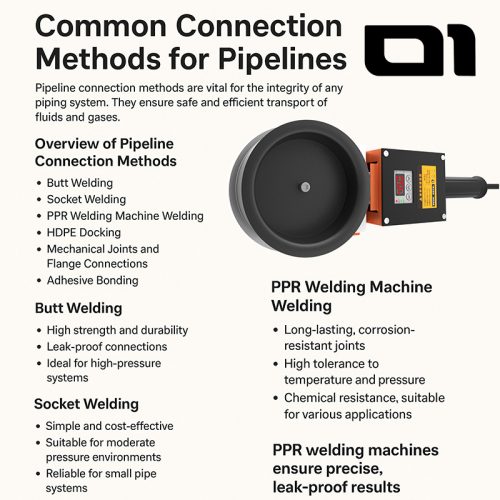Pipeline connection methods are vital for the integrity of any piping system. They ensure safe and efficient transport of fluids and gases.
Choosing the right method directly impacts durability, maintenance requirements, and long-term system performance. Engineers and construction professionals must understand the strengths of each method to make informed decisions.
This guide highlights the most common pipeline connection methods, with particular attention to PPR welding machines, which have become a key solution in modern plumbing and heating systems.
Overview of Pipeline Connection Methods
Pipeline connections are critical for maintaining system performance and safety. Each method is suited to different materials and environments. Selecting the right option requires balancing technical requirements, pipe characteristics, and regulatory standards.
The most common connection methods include:
- Butt Welding
- Socket Welding
- PPR Welding Machine Welding
- HDPE Docking
- Mechanical Joints and Flange Connections
- Adhesive Bonding
Butt Welding
Butt welding is one of the strongest ways to join pipes. It involves heating and joining the ends of two pipes to create a seamless, pressure-resistant bond.
Advantages:
- High strength and durability
- Leak-proof connections
- Ideal for high-pressure systems
However, this method requires skilled operators and precise equipment to ensure long-lasting quality.
Socket Welding
Socket welding is commonly used for small-diameter pipes. One pipe end is inserted into the socket of another, and the joint is welded.
Advantages:
- Simple and cost-effective
- Suitable for moderate pressure environments
- Reliable for small pipe systems
This method is not recommended for large-scale or high-pressure pipelines.
PPR Welding Machine Welding
PPR welding machines are specifically designed for polypropylene (PPR) pipes, widely used in plumbing, hot water, and heating systems. The process involves heating the pipe ends with a specialized machine until they melt, then pressing them together to form a seamless connection.
Key Benefits of PPR Welding:
- Long-lasting, corrosion-resistant joints
- High tolerance to temperature and pressure
- Chemical resistance, suitable for various applications
With proper handling, PPR welding machines ensure precise, leak-proof results. This makes them the preferred choice for modern residential, commercial, and industrial piping systems. For manufacturers and contractors, investing in reliable PPR fusion technology is critical to delivering quality and efficiency.
HDPE Docking
HDPE docking is used for high-density polyethylene pipes. It provides flexible, durable connections suitable for gas, water supply, and industrial use.
Advantages:
- Strong resistance to corrosion and chemicals
- Lightweight and easy to install
- High flexibility and durability
This method is particularly valuable in underground and underwater projects.
Mechanical Joints and Flange Connections
Mechanical joints and flange connections offer flexibility where welding is not practical. Flanges allow for easy disassembly and maintenance, while couplings and clamps enable quick system modifications.
Advantages:
- Easy assembly and disassembly
- Adaptability for design changes
- Suitable for both metallic and non-metallic pipes
Adhesive Bonding and Specialized Methods
Adhesive bonding chemically joins pipe surfaces and is often used for non-metallic pipes like PVC or fiberglass. Other specialized methods include electrofusion and thermal fusion, particularly for plastics.
Advantages:
- Corrosion resistance
- Flexibility in joining dissimilar materials
- Cost-effective for specific cases
Factors Influencing the Choice
When selecting a connection method, consider:
- Pipe material compatibility
- Environmental conditions (temperature, chemicals, humidity)
- Cost efficiency and maintenance requirements
Balancing these factors ensures a system that is both reliable and cost-effective.
Best Practices
- Use certified professionals and high-quality equipment
- Conduct regular inspections and preventive maintenance
- Keep records of installation and service history
For PPR systems, using a high-performance welding machine ensures consistent results and extends the pipeline’s lifespan.
Conclusion
Pipeline connection methods vary depending on material, environment, and performance requirements. From butt welding to mechanical joints, each has distinct advantages.
Among them, PPR welding machines stand out as a modern, efficient, and durable solution for water supply and heating systems. For businesses and contractors, leveraging advanced PPR fusion technology is key to achieving secure, long-lasting pipeline installations.









